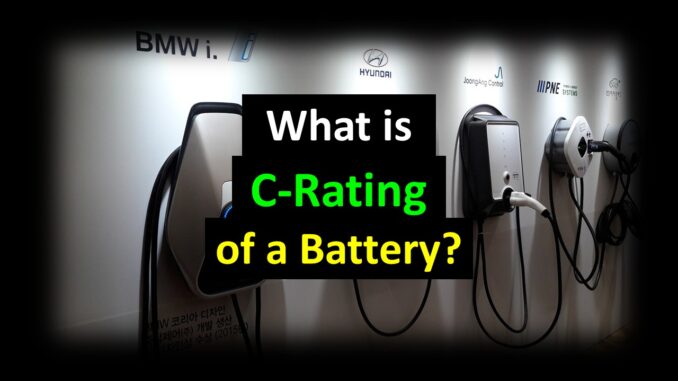
One of the important parameters of a rechargeable battery is the C-rating. Along with the Ah capacity, Voltage, etc., the C-rating of a battery is also necessary to understand how the battery could behave while charging and discharging. The parameter “C-ratinng” defines the maximum safe charge/discharge limit of a battery.
C-Rating of a battery
The “C rating” refers to the charge/discharge rate capability of a battery. It is a measure of how quickly the battery can safely deliver its stored energy. The C rating is typically represented as a multiple of the battery’s capacity.
For example, if a battery has a capacity of 1000mAh and a C rating of 1C, it means the battery can discharge at a rate of 1000mA without exceeding its recommended discharge limits. So, it takes minimum of 1 hr. to safely charge from 0 to 100% of its capacity (SoC).
Similarly, a battery with a 2C rating could discharge at a rate of 2000mA. In this case, it takes minimum half an hour to fully charge.
If the rating is C/2 or 0.5C, then the charging/discharging rate is at 500mA and the battery could charge or discharge at this rate. (It takes 2 hours to fully charge the battery)
Why C-Rating is important?
The C rating is important to consider while selecting the batteries for applications that require high power output or fast discharge rates. It helps to ensure that the battery can handle the necessary current without overheating, voltage sag, or damage.
In the case of electric vehicle batteries, a higher C-rating is necessary to have fast charging capability. To accept a higher current, the battery has to have a higher C rating.
Moreover, to accelerate a vehicle quickly the battery should be capable of delivering a higher current. The C-rating does matter here.
Different types of batteries may have different C rating systems, so it’s important to refer to the manufacturer’s specifications and guidelines to ensure proper usage and safety.
Impacts of higher C-rating
Charging and discharging of batteries at a higher rate causes faster degradation and reduced battery life.
It is believed that the Lithium Dendrite formation is the root cause of this. When a lithium-ion battery is subjected to abnormal conditions like overcharging, charging at faster rates, or charging at lower temperatures, it can experience a detrimental occurrence known as lithium dendrite growth or lithium plating.
During the charging process, metallic microstructures called lithium dendrites form on the negative electrode. These dendrites develop when there is an accumulation of excess lithium ions on the anode surface that cannot be promptly absorbed.
The presence of lithium dendrites can lead to short circuits, posing a severe risk of catastrophic failures and even fires.
An investigation into the Samsung Galaxy Note 7 battery incidents in 2016 discovered that lithium dendrites were responsible for internal short circuits. Another concern associated with lithium dendrite growth is capacity fade.
As the dendrites interact with the electrolyte, it causes decomposition and results in the loss of active lithium content within the battery. This capacity loss gradually accumulates alongside the progression of lithium dendrite growth.Top of Form
Conclusion
We have discussed the c-rating of a battery in this blog post. We explained the importance of c-rating, impacts of c-rating, etc. as well.
Batteries with a higher c-rating is necessary for convenient operation of electric vehicles but the life of the batteries could not be compromised. So, the latest battery technologies have to be found out to incorporate both the higher rating and longer life together.
